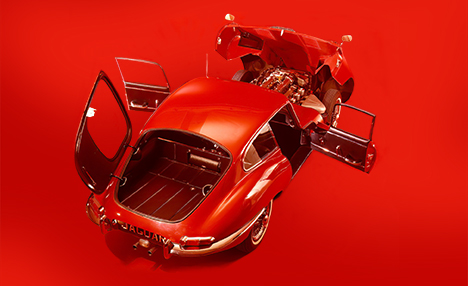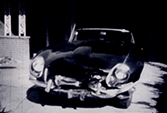A little piece of motoring history was made on Thursday, May 21, 1992 when British Motor Heritage announced the addition of the TR6 bodyshell to their range of remanufactured items for classic vehicles.
I consulted my notes on this project to find that it was early September 1989 when David Bishop and I sat down with Peter Wigglesworth, Moss Europe’s Cox & Buckles Triumph R&D specialist, to review the panels that were available for the TR6. Our intent was to consider the feasibility of retooling all the missing items in order that an assembly jig could be built to actually construct complete TR6 bodies.
At that stage it seemed to be a some what ambitious project, verging on a dream. In this analysis, I had reckoned without the skill and tenacity of David Bishop, Jack Bellinger and the team of experienced professional motor body builders, that David had assembled in Faringdon, Oxfordshire.
Following the announcement of the body shell on May 21, 1992. we assembled a team of three mechanics from Moss Europe’s Cos & Buckles work shop and two British Motor Heritage employees. Alan Sinclair has worked in Moss Europe’s Cox & Buckles workshop for the last ten years and is a former tool maker with a dedication to doing an accurate, thorough job on any project that he undertakes. Much of the preliminary work in preparing the vehicle for the rebuild was carried out by a relatively recent recruit. Mark Jensen, who was joined by Alan Warner, a veteran of two or three previous rebuilds, to make Moss Europe’s Cox & Buckles team. Mark Gamblc, a TR6 owner, works for British Motor Heritage and is currently on loan to Rover on a project so secret, that I am not allowed to mention the fact that it is the building of the MGB RV8. Paul Gilder, who works on the British Motor Heritage vehicle collection in Studley, was appearing at a rebuild for the first time, and rounded out the five man team. Commentary on the rebuild was provided by Graham Paddy and myself.
What an exciting weekend it was.
The scene was set when, at 1100 hours on Saturday morning, Neale James, a Radio One disc jockey, pulled back the cover on the first TR6 body shell to be built for around fifteen or sixteen years. It had only come out of its priming paint process on May 14, 1992, and had been painted French Blue for the show on May 20, 1992. The donor vehicle, registration number SBU 523M, was also on the stand as was the reconditioned chassis from this donor vehicle.
The first job that the team embarked on was to undo all the bolls securing the body from the donor vehicle to its chassis. This task was achieved in the remarkably quick time of an hour and a quarter (but remember, they had all been undone in the recent past and there were five dedicated professionals working on this task), the chassis from the donor car was stripped of its front and rear suspensions and the engine and gearbox were removed. Simultaneously, with the stripping of the chassis the items, which would be used from the donor vehicle, were taken off the rather sad, sorry looking, old body shell.
By lunch break, the donor chassis had been stripped and the assembly process of the reconditioned chassis had started, but only the fuel pipes from the front to the back of the car had been fitted. The wiring harness had been laid in the new shell and positioned. The reconditioned chassis was, by Saturday evening, fitted with front and rear suspension, engine and gearbox, rear axle and propeller shaft. The new shell had been fitted with all its lamps and several electrical components in the inner engine compartment. Work was completed at 1740 hours when the team returned to the hotel for a swim and an enjoyable supper, content that all that was scheduled had been installed.
Sunday morning was probably the most spectacular session of the rebuild. Work continued on the final strip-down of the body shell to remove things such as the steering column and heater motor. More progress was made on the new shell, including the fitting of the gas tank, the fuel injection pipe work and various other bits and pieces, including the beginnings of the re-assembly of the doors with their guide channels and bracketing. The chassis had all the brakes assembled to the running gear and all the chassis-based pipe work completed.
At around 1130 hours there was the impressive and very rewarding sight of eight people lifting shoulder high the French Blueshell and then carefully lowering the front end onto the location studs of the now completed rolling chassis. The body was held high for a couple of minutes as Peter Wigglesworth and Graham Paddy juggled the front end of the chassis to locate it gently onto the two studs on the forward-most piece of the chassis. The body was then gently lowered at the rear end. A small snag was encountered when the earthing strap mounted to the bulk head at the front of the battery box fouled on the fuel injection metering unit. Rapid action with a spanner removed the earthing strap and within three or four minutes, the bodyshell was nestling gently on the chassis. As an observer to this process, I was feeling quite tired (how the people carrying out the hard work felt, I did not find out), but I will say that lunch was taken at 1210 hours.
From a visual entertainment point of view, Saturday afternoon was probably the most disappointing session of all. Around an hour and a half was spent by four or five people setting the body shell on the chassis. This involves using the cortex packing pieces that go between the body and the chassis to “shim” the body against the chassis, in order to achieve close to perfect door gaps. This process is an essential, but often forgotten, part of a rebuild and the fact that almost one man day went into the job in our rebuild, shows how much importance we attach to this aspect. During the rest of the afternoon, the pipe work was joined from the rolling chassis to the bodyshell, the rear bumpers were fitted and the assembly of the doors was completed.
The team returned to the hotel that evening slightly worried that the progress made may have fallen short of what was required to finish on time. British Motor Heritage hosted a dinner that evening with free wine. This was seen by myself as a potential major deterrent to achieving a full team on parade early the next morning! Dinner was enjoyable and included another really excellent speech from Michael Maddox, and some interesting stories told by Russell Brookes concerning his rallying days. Despite the fact that most of the team climbed into their beds after 0130 hours on Monday morning, we still managed to have a full team working at 0830 hours on Monday morning.
Monday was a day of activity with some jobs being undertaken “on the double”, while other jobs were undertaken with slow meticulous care. Mark and Paul in particular, spent almost two hours patiently ensuring that the new harness installed under the dashboard was connected to exactly the right components. Incidentally, on the first day, there was a less than patient Mark Jensen who, having failed to fit the front suspension three times, dropped it and following a “witty quip” (at least that is what I thought it was) threatened that I would be wearing the front suspension if I did not shut up. I shut up.
A short lunch break was taken on Monday, and on return the installation of the interior trim continued. We had been lucky enough on Saturday afternoon to have a demonstration from Lol Smith of Callow &Maddox, the suppliers of all Moss Europe’s Cox & Buckles TR6 trim, on exactly how to make a perfect re-covering of a TR6 seat. The job took just under an hour, and In the demonstration he showed a few tricks of the trade and emphasized that patience was probably the trimmer’s most valuable tool. The seals that he trimmed on Saturday were installed in the new body on Sunday afternoon. The target was to have the car finished and ready to fire up at 1600 hours. 1600 hours came and went, the crowd was six or seven deep, and the job-continued. By 1615 hours, however, the job was completed and Neale James (who had three days earlier unveiled the shell) came onto our stand, and following a short exchange of banter with myself, sat in the car ready to fire it up.
Neale had been fully briefed as to the fact that the fuel injection system on TR6s can be temperamental and was given a 15-point action plan as to “how not to ruin the demonstration” by flattening the battery or causing a fire, etc. We need not have worried. As Neale touched the key. the engine burst into life and the crowd burst into a spontaneous round of applause. To have a TR6 fire up and run beautifully the first time it has been connected up was an amazing and surprising feat. My flabber has rarely been so gasted. Following a few blips on the throttle and a short run of the engine, the car was turned off and Neale presented the keys to the car to David Bishop of British Motor Heritage.
The vehicle will be held by British Motor Heritage in its collection of Triumph and other lesser vehicles. It was certainly a great privilege for me to be there and participate on that day when a little piece of motoring history was made.
By Pete Buckles. Managing Director. Moss Europe







'The Heritage TR6 Body Shell – A Piece Of Motoring History' has no comments
Be the first to comment this post!